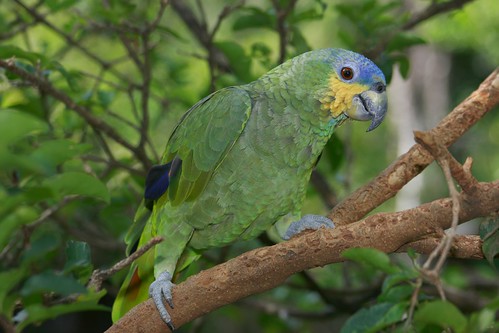

The Orange-winged Amazon (Amazona amazonica), also known locally as Orange-winged Parrot and Loro Guaro, is a large Amazon parrot. It is a resident breeding bird in tropical South America, from Colombia, Trinidad and Tobago south to Peru and central Brazil. Its habitat is forest and semi-open country. Although common, it is persecuted as an agricultural pest and by capture for the pet trade (over 66,000 captured in the years 1981-1985). It is also hunted as a food source.
Taxonomy
There are two subspecies:
A. a. amazonica, found on the mainland of South America.
A. a. tobagensis, found only on Trinidad and Tobago, is a subspecies which is larger then the nominate form, and has more orange in the wing.
There are two subspecies:
A. a. amazonica, found on the mainland of South America.
A. a. tobagensis, found only on Trinidad and Tobago, is a subspecies which is larger then the nominate form, and has more orange in the wing.
Description
The Orange-winged Amazon is a mainly green parrot about 33 cm (13 in) long and weighing about 340 gm. It has blue and yellow feathers on its head which varies in extent between individuals. The upper mandible is partly horn coloured and partly dark-grey. It has orange feathers in the wings and tail, which can be seen when in flight. The male and female are identical in external appearance.[1]
Behaviour
Diet and feeding
The Orange-winged Amazons is a noisy bird and makes loud, high-pitched screams. It eats fruit and seeds, including the fruit of palm trees and sometimes cocoa. It roosts communally in palm and other trees, and large numbers can be seen at the roost sites at dawn and dusk. It is becoming common as a feral bird in the Miami, Florida area of the USA.
The Orange-winged Amazons is a noisy bird and makes loud, high-pitched screams. It eats fruit and seeds, including the fruit of palm trees and sometimes cocoa. It roosts communally in palm and other trees, and large numbers can be seen at the roost sites at dawn and dusk. It is becoming common as a feral bird in the Miami, Florida area of the USA.
Breeding
The Orange-winged Amazon nests in tree cavities. The eggs are white and there are usually three to four in a clutch. The female incubates the eggs for about 26 days and the chicks leave the nest about 60 days after hatching.[1]
The Orange-winged Amazon nests in tree cavities. The eggs are white and there are usually three to four in a clutch. The female incubates the eggs for about 26 days and the chicks leave the nest about 60 days after hatching.[1]
Breeding/Reproduction: These amazons are commonly bred in captivity. At the onset of warm weather (April to early May) courtship will begin. The hen will then lay two to four eggs which incubate for about 28 days. The young will leave the nest at 8-10 weeks. As with many parrots, the male will eat for both himself and the female while she incubates the eggs and feeds the young. The male regurgitates the food for the female to eat. He gets a lot less picky about what he eats at these times!
Potential Problems: These birds are hardy and healthy if provided with a good environment and a good diet. Amazons can be noisy first thing in the morning, and just before the sun sets. This is easy to control, they can often be quieted by just covering their cage for a short period of time.
References
^ a b Alderton, David (2003). The ultimate encyclopedia of caged and aviary birds. London, England: Hermes House, p. 231. ISBN 184309164X.
BirdLife International (2004). Amazona amazonica. 2006 IUCN Red List of Threatened Species. IUCN 2006. Retrieved on 11 May 2006. Database entry includes justification for why this species is of least concern
Birds of Venezuela by Hilty, ISBN 0-7136-6418-5
ffrench, Richard (1991). A Guide to the Birds of Trinidad and Tobago, 2nd edition, Comstock Publishing. ISBN 0-8014-9792-2.
"National Geographic" Field Guide to the Birds of North America ISBN 0-7922-6877-6
Handbook of the Birds of the World Vol 4, Josep del Hoyo editor, ISBN 84-87334-22-9
"National Audubon Society" The Sibley Guide to Birds, by David Allen Sibley, ISBN 0-679-45122-6

No comments:
Post a Comment